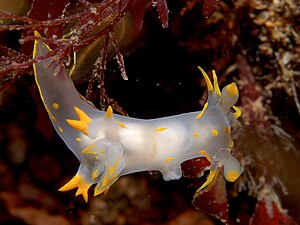Faroese squirrel snail
| Faroese squirrel snail | ||||||||||||
|---|---|---|---|---|---|---|---|---|---|---|---|---|

Polycera faeroensis , Strangford Lough, Northern Ireland |
||||||||||||
| Systematics | ||||||||||||
|
||||||||||||
| Scientific name | ||||||||||||
| Polycera faeroensis | ||||||||||||
| Lemche , 1929 |
The Faroese squirrel snail ( Polycera faeroensis ), called Bertákna in Faroese , is a hind- gill snail belonging to the group of nudibranchs (Nudibranchia). It belongs to the molluscs (Mollusca) and there to the snails (Gastropoda).
features
The body of the Faroese squirrel snail is transparent with bright yellow "squirrels" and spots. This species is larger than other squirrels, up to 45 mm long compared to 20 to 25 mm of the other species. The snail usually has more than eight tentacles on its head, compared to four to six in the closely related striped squirrel snail ( Polycera quadrilineata ).
Occurrence and distribution
The Faroese squirrel snail is common in the eastern North Atlantic . Finds are documented off the coasts of the Faroe Islands , France , Ireland , Channel Islands , Norway , Scotland , Sweden and Spain .
Discovery story
A specimen of the Faroese squirrel snail was first found in June 1899 in the deep gullies between Nólsoy and Eysturoy in the Faroe Islands. The Danish back gill expert Henning Lemche described the species in The Zoology of the Faroes from 1929. The specimen was in relatively bad shape, but the shape and size of the rasp tongue made it a new species. Later finds have shown that the species is larger than other close relatives.
Faroese word origin
The name Bertákna is made up of bera (= naked common Germanic related to bar, see barefoot ) and tákn (= gills and also: beards, possibly common Germanic related to spikes and / or rigging , tentacles ). Bertákna means nudibranch , and that is the correct zoological name for this animal, which is strictly speaking a bare hindgill .
literature
- Ad. S. Jensen, W. Lundbeck, Th. Mortensen: The Zoology of the Faroes , Andreas Frederik Høst og Søn, Copenhagen 1928–1942 (3 volumes of 2 parts, standard work, reprinted in various excerpts later)
- TE Thompson, GH Brown: Biology of Opisthobranch Molluscs , Vol 2. Ray Society, London 1984
